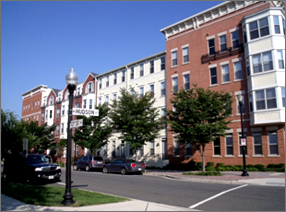According to the U.S. Green Building Council (USGBC), there are 29 LEED (Leadership in Energy and Environmental Design) certified projects in Arlington County, Virginia. Located across the Potomac River from Washington, D.C., the seventh fastest growing county in the nation is a vibrant mix of high-density, mixed-use districts oriented around transit stops. Within the last three decades, Arlington has adopted a wide range of land use planning tools and programs to promote energy-efficient and environmentally-sustainable development. The county is also one of the few communities in the nation to provide density bonuses to encourage green building through its Green Building Incentive Program.
 Green Building Incentive Program Green Building Incentive Program
First adopted in 1999, the incentive program targeted large commercial developments requiring special exceptions to the existing zoning ordinance. The program, based on LEED standards, offered a 0.25 floor area ratio (FAR) bonus for office buildings achieving Silver LEED certification (FAR is the ratio of gross floor area of a building to the total site area). In 2003, the program was expanded to allow increased FAR bonuses for all mixed-use, commercial, and multifamily residential buildings at all LEED levels. At this time, the county also created a Green Building Fund requiring developers of projects not achieving LEED certification to contribute $0.03 per square foot to the fund. The funds are utilized for educational and outreach activities related to green building issues.
Last year, the county board further increased FAR bonuses for projects achieving the highest LEED certification at the Platinum level. Current program requirements also allow an additional 0.05 FAR bonus for projects with a multifamily housing component to encourage LEED certification for residential uses. To date, 2,313 residential units in the county were approved with the green incentive bonus. Two mid-rise multifamily developments totaling 132 units received Silver LEED certification this year. While the program is not mandatory, the county board has the authority to impose green building requirements for all site plan projects, which are development proposals that require a special exception to the zoning ordinance. Site plan projects that involve additional height or density provisions must achieve LEED certification. The county ensures compliance by requiring developers to post a bond which is released only after the projects receive certification from USGBC.
Incentives for Green Homes
In addition to the increased FAR bonuses for large projects incorporating multifamily units, the county requires high-density multifamily developments to meet the Environmental Protection Agency's ENERGY STAR® standards for appliances and fixtures in the housing units. For affordable housing projects that incorporate green features, developers can utilize a combination of green building and affordable housing density bonuses. The green density bonuses are not applicable to single-family housing; however, the county's Green Home Choice program, based on the EarthCraft Virginia rating system, a certification process similar to LEED, provides support and resources for developers and homeowners looking to incorporate green building features in single-family homes. EarthCraft is supported by a number of partnerships, including Southface, a nonprofit organization that promotes energy and water efficiency in homes and communities throughout the Southeast. A guidance manual available on the county website lists various green features that homeowners can implement in order to receive green home certification. Developers of certified homes receive expedited permitting and recognition as green builders.
Conclusion
Local government policies play a pivotal role in fostering sustainable development practices. Through its green building programs, Arlington is successfully promoting healthier homes and sustainable communities. The county’s approach of judiciously applying regulatory tools – such as density bonuses – within the municipal zoning framework to encourage sustainable development is a strategy that can also prove beneficial to municipalities throughout the nation.
Previous Search Archive
|


